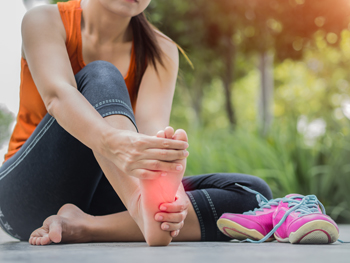
Running is a popular way to exercise, but if care is not taken, it can cause several injuries to the feet and ankles. Most common among them are plantar fasciitis, ankle sprains, stress fractures, and Achilles tendon tears. Experts recommend these procedures to help prevent injuries from running. First, warm up before you start by walking or light jogging and then performing stretches, such as lunges and knee raises. Next, be certain you have the proper footwear, both for your feet and for the type of running you are doing. A properly fitting shoe, with ample cushioning and arch support, is essential to warding off injury. Be sure to increase the time, distance, and intensity of your runs gradually. A rule of thumb is not to increase distance or intensity by more than 10 percent per week. If you begin to feel pain when running, it is wise to pay attention to it. Running through the pain can make the injury worse. Finally, stretch and give your feet and ankles a chance to rest after running. If you sustain a running injury that persists or worsens, it is suggested that you make an appointment with a podiatrist.
All runners should take extra precaution when trying to avoid injury. If you have any concerns about your feet, contact one of our podiatrists of Lovely Foot Associates, PC. Our doctors will treat your foot and ankle needs.
How to Prevent Running Injuries
There are a lot of mistakes a runner can make prior to a workout that can induce injury. A lot of athletes tend to overstretch before running, instead of saving those workouts for a post-run routine. Deep lunges and hand-to-toe hamstring pulls should be performed after a workout instead of during a warmup. Another common mistake is jumping into an intense routine before your body is physically prepared for it. You should try to ease your way into long-distance running instead of forcing yourself to rush into it.
More Tips for Preventing Injury
If you have any questions, please feel free to contact our office located in Johnstown, PA . We offer the newest diagnostic and treatment technologies for all your foot care needs.

A hammertoe is when there is a deformity of the middle joint of a toe and the toe bends up or down abnormally, resembling a hammer. Hammertoe typically happens to the second, third, or fourth toes, but can also occur on the pinky toe. This condition happens from an imbalance in muscles, ligaments, and tendons in the middle joint of the toe. It can be caused by wearing shoes that do not have enough room in the toe box, foot type and structure, or injury to the foot. A hammertoe can become painful, making it difficult to walk, and it may be hard to find shoes to comfortably accommodate the abnormality. Depending on the severity of the hammertoe, stretching and strengthening exercises can help straighten the toe and minimize discomfort. Such exercises include towel toe curls, where one sits in a chair with their feet flat on a towel placed on the floor. One then can curl their toes and try to scrunch up the towel followed by extending the toes to push the scrunched towel forward. It is suggested that this be done 10 times and three times a day. Another exercise is sitting on the edge of a chair or a bed, placing the affected leg on the opposite knee, and bending the toes toward the body and then away from the body. Each position should be held for 30 to 40 seconds, and three to five sets should be done three times a day. If you are having a problem with hammertoe, it is suggested that you consult with a podiatrist who can provide additional exercises and assess the proper treatment for you.
Hammertoes can be a painful condition to live with. For more information, contact one of our podiatrists of Lovely Foot Associates, PC. Our doctors will answer any of your foot- and ankle-related questions.
Hammertoe
Hammertoe is a foot deformity that occurs due to an imbalance in the muscles, tendons, or ligaments that normally hold the toe straight. It can be caused by the type of shoes you wear, your foot structure, trauma, and certain disease processes.
Symptoms
Risk Factors
Treatment
If you have hammertoe, you should change into a more comfortable shoe that provides enough room for your toes. Exercises such as picking up marbles may strengthen and stretch your toe muscles. Nevertheless, it is important to seek assistance from a podiatrist in order to determine the severity of your hammertoe and see which treatment option will work best for you.
If you have any questions, please feel free to contact our office located in Johnstown, PA . We offer the newest diagnostic and treatment technologies for all your foot care needs.
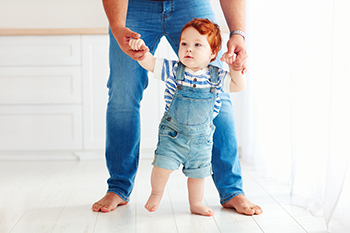
It is beneficial for parents to pay attention to their children’s feet as they are growing. The majority of babies are born with flat feet, and the arch generally develops during their teenage years. If this fails to occur, orthotics may be needed that may help to strengthen the foot. A foot care routine can begin with washing the child’s feet, and ensuring the area between the toes is thoroughly dried. This can be followed by trimming the toenails properly, which is typically done once per week. The feet can become stronger when babies crawl barefoot while indoors, as a result of the toes gripping the floor. When it is time to walk outside, it is beneficial for the first shoes to be made with a sturdy sole and flexible materials. The feet have several thousand sweat glands, and while sweating is normal, there may be an offensive odor. It is suggested to discuss this with a podiatrist, in addition to any information you would like to know about children’s foot health.
Making sure that your children maintain good foot health is very important as they grow. If you have any questions, contact one of our podiatrists of Lovely Foot Associates, PC. Our doctors can provide the care you need to keep you pain-free and on your feet.
Keeping Children's Feet Healthy
Having healthy feet during childhood can help prevent medical problems later in life, namely in the back and legs. As children grow, their feet require different types of care. Here are some things to consider...
Although babies do not walk yet, it is still very important to take care of their feet.
Avoid putting tight shoes or socks on his or her feet.
Allow the baby to stretch and kick his or her feet to feel comfortable.
As a toddler, kids are now on the move and begin to develop differently. At this age, toddlers are getting a feel for walking, so don’t be alarmed if your toddler is unsteady or ‘walks funny’.
As your child gets older, it is important to teach them how to take care of their feet.
Show them proper hygiene to prevent infections such as fungus.
Be watchful for any pain or injury.
Have all injuries checked by a doctor as soon as possible.
Comfortable, protective shoes should always be worn, especially at play.
If you have any questions please feel free to contact our office located in Johnstown, PA . We offer the newest diagnostic and treatment technologies for all your foot and ankle needs.

Slamming and smashing our feet into the pavement as we skateboard can take its toll on the ankles and feet. The most frequent foot and ankle problems skateboarders encounter are heel bruises, flat feet, and ankle rolls. If you skateboard and want to continue doing this for some time, it is important to take care of your feet. Wash, dry, and moisturize them daily. Wear properly fitting skate shoes and only wear them for skating. When the feet are sore, take a break, rest, and even soak the feet. Skate shoes do not provide the best support in terms of padding and arch support. Extra support in the heel of skate shoes may help prevent heel bruises. A looser-fitting shoe and gel inserts might help with foot pain caused by flat feet. If you are into skateboarding and are experiencing foot problems, it is suggested that you make an appointment with a podiatrist for an evaluation and treatment options.
Sports related foot and ankle injuries require proper treatment before players can go back to their regular routines. For more information, contact one of our podiatrists of Lovely Foot Associates, PC. Our doctors can provide the care you need to keep you pain-free and on your feet.
Sports Related Foot and Ankle Injuries
Foot and ankle injuries are a common occurrence when it comes to athletes of any sport. While many athletes dismiss the initial aches and pains, the truth is that ignoring potential foot and ankle injuries can lead to serious problems. As athletes continue to place pressure and strain the area further, a mild injury can turn into something as serious as a rupture and may lead to a permanent disability. There are many factors that contribute to sports related foot and ankle injuries, which include failure to warm up properly, not providing support or wearing bad footwear. Common injuries and conditions athletes face, including:
Sports related injuries are commonly treated using the RICE method. This includes rest, applying ice to the injured area, compression and elevating the ankle. More serious sprains and injuries may require surgery, which could include arthroscopic and reconstructive surgery. Rehabilitation and therapy may also be required in order to get any recovering athlete to become fully functional again. Any unusual aches and pains an athlete sustains must be evaluated by a licensed, reputable medical professional.
If you have any questions please feel free to contact our office located in Johnstown, PA . We offer the newest diagnostic and treatment technologies for all your foot and ankle needs.

Although a pregnant woman might not initially think that they should pay attention to the health of their feet during pregnancy, there are many reasons for her to monitor the health of her feet as she carries her baby to term. First, the woman’s feet may increase in size. Second, the pregnant woman could potentially experience changes to her skin. For example, many pregnant women might experience cracked heels, where the skin around the back of the heel becomes significantly dehydrated. It is important to note that if a pregnant woman experiences continuous itching on their feet, it is suggested that they schedule an appointment with a trusted medical professional like a podiatrist. If you are pregnant, you can schedule an appointment with a podiatrist today.
Pregnant women with swollen feet can be treated with a variety of different methods that are readily available. For more information about other cures for swollen feet during pregnancy, consult with one of our podiatrists from Lovely Foot Associates, PC. Our doctors will attend to all of your foot and ankle needs.
What Foot Problems Can Arise During Pregnancy?
One problem that can occur is overpronation, which occurs when the arch of the foot flattens and tends to roll inward. This can cause pain and discomfort in your heels while you’re walking or even just standing up, trying to support your baby.
Another problem is edema, or swelling in the extremities. This often affects the feet during pregnancy but tends to occur in the later stages.
How Can I Keep My Feet Healthy During Pregnancy?
If you have any questions please feel free to contact our office located in Johnstown, PA . We offer the newest diagnostic and treatment technologies for all your foot and ankle needs.
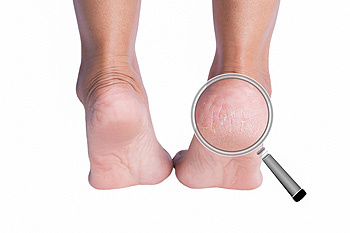
If you are someone that is prone to cracked heels, then you ought to be especially aware of the possibility of developing an infection because of this condition. Cracked heels occur when the skin covering the heel becomes severely dehydrated and fissures begin to form on the skin. As a result of these fissures, the skin might even start to bleed. Infections are an important risk to be aware of if you have cracked heels. Specifically, if an individual removes skin on the heels through a process known as debridement, an infection might occur. For example, if too much skin is removed with a razor, then the individual might be setting themselves up for a nasty infection. If you have cracked heels, it is suggested that you see a podiatrist promptly. This medical professional will be able to help you treat your condition and answer any questions you might have.
If the skin on your feet starts to crack, you may want to see a podiatrist to find treatment. If you have any concerns, contact one of our podiatrists from Lovely Foot Associates, PC. Our doctors can provide the care you need to keep you pain-free and on your feet.
Cracked Heels
It is important to moisturize your cracked heels in order to prevent pain, bleeding, and infection. The reason cracked heels form is because the skin on the foot is too dry to support the immense pressure placed on them. When the foot expands, the dry skin on the foot begins to split.
Ways to Help Heal Them
Ways to Prevent Cracked Heels
If you are unsure how to proceed in treating cracked heels, seek guidance from a podiatrist. Your doctor will help you with any questions or information you may need.
If you have any questions, please feel free to contact our office located in Johnstown, PA . We offer the newest diagnostic and treatment technologies for all your foot care needs.
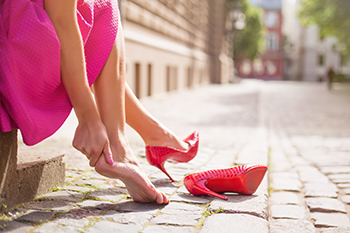
Although it might not seem immediately obvious, the kinds of shoes that you wear can have a discernible impact on the health of your feet. For example, if you wear non-supportive, flimsy footwear, this can spell trouble for the strength and resilience of your feet. High heels are one such kind of potentially detrimental footwear. The impact that high heels can have on your feet and body is sometimes referred to as high heel syndrome. As a result of overuse of high heels, an individual might experience anatomical changes in their legs. Typically these individuals will have Achilles tendons that are more stiff. When an individual is experiencing high heel syndrome, they may benefit significantly from stretching exercises that target the calves. If you are someone who wears high heels frequently, consider contacting a podiatrist for more information and support.
High heels have a history of causing foot and ankle problems. If you have any concerns about your feet or ankles, contact one of our podiatrists from Lovely Foot Associates, PC. Our doctors can provide the care you need to keep you pain-free and on your feet.
Effects of High Heels on the Feet
High heels are popular shoes among women because of their many styles and societal appeal. Despite this, high heels can still cause many health problems if worn too frequently.
Which Parts of My Body Will Be Affected by High Heels?
What Kinds of Foot Problems Can Develop from Wearing High Heels?
How Can I Still Wear High Heels and Maintain Foot Health?
If you want to wear high heeled shoes, make sure that you are not wearing them every day, as this will help prevent long term physical problems. Try wearing thicker heels as opposed to stilettos to distribute weight more evenly across the feet. Always make sure you are wearing the proper shoes for the right occasion, such as sneakers for exercising. If you walk to work, try carrying your heels with you and changing into them once you arrive at work. Adding inserts to your heels can help cushion your feet and absorb shock. Full foot inserts or metatarsal pads are available.
If you have any questions please feel free to contact our office located in Johnstown, PA . We offer the newest diagnostic and treatment technologies for all your foot and ankle needs.
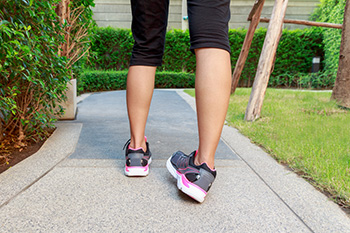
A twisted ankle is the most common cause of torn ligaments, also called ankle sprains. The foot rolls under and over-stretches the ligament that helps to stabilize the ankle joint. This can occur while stepping off a curb, landing on the foot wrong while walking or running, or playing sports where a lot of running and jumping are involved. Symptoms of an ankle sprain include pain, bruising, a loose feeling in the joint, and difficulty bearing weight. The incident may have generated a popping sound, and the ankle may begin to swell. The first way to deal with a sprained ankle is to cease the activity. Depending on the severity of the sprain, you may wish to see a medical professional, such as a podiatrist, as soon as possible. In the meantime wrapping the ankle to keep down the swelling, keeping it elevated, and applying ice is a good stopgap measure. It is exceedingly important to allow an ankle sprain to heal completely. If this is ignored, the chances are that the ankle will be re-injured, and sprains may become a chronic condition. For more information about an ankle sprain, please consult a podiatrist for an exam and long term treatment plan.
Although ankle sprains are common, they aren’t always minor injuries. If you need your ankle injury looked at, contact one of our podiatrists from Lovely Foot Associates, PC. Our doctors can provide the care you need to keep you pain-free and on your feet.
How Does an Ankle Sprain Occur?
Ankle sprains are the result of a tear in the ligaments within the ankle. These injuries may happen when you make a rapid shifting movement while your foot is planted. A less common way to sprain your ankle is when your ankle rolls inward while your foot turns outward.
What Are the Symptoms?
Preventing a Sprain
Treatment of a Sprain
In many cases, the RICE method (Rest, Ice, Compression, and Elevate) is used to treat ankle sprains. However, you should see a podiatrist to see which treatment option would work best with your injury. In severe cases, surgery may be required.
It is important to ask your doctor about rehab options after you receive treatment for your injury. Stretching, strength training, and balance exercises may help the ankle heal while also preventing further injury.
If you have any questions, please feel free to contact our office located in Johnstown, PA . We offer the newest diagnostic and treatment technologies for all your foot care needs.